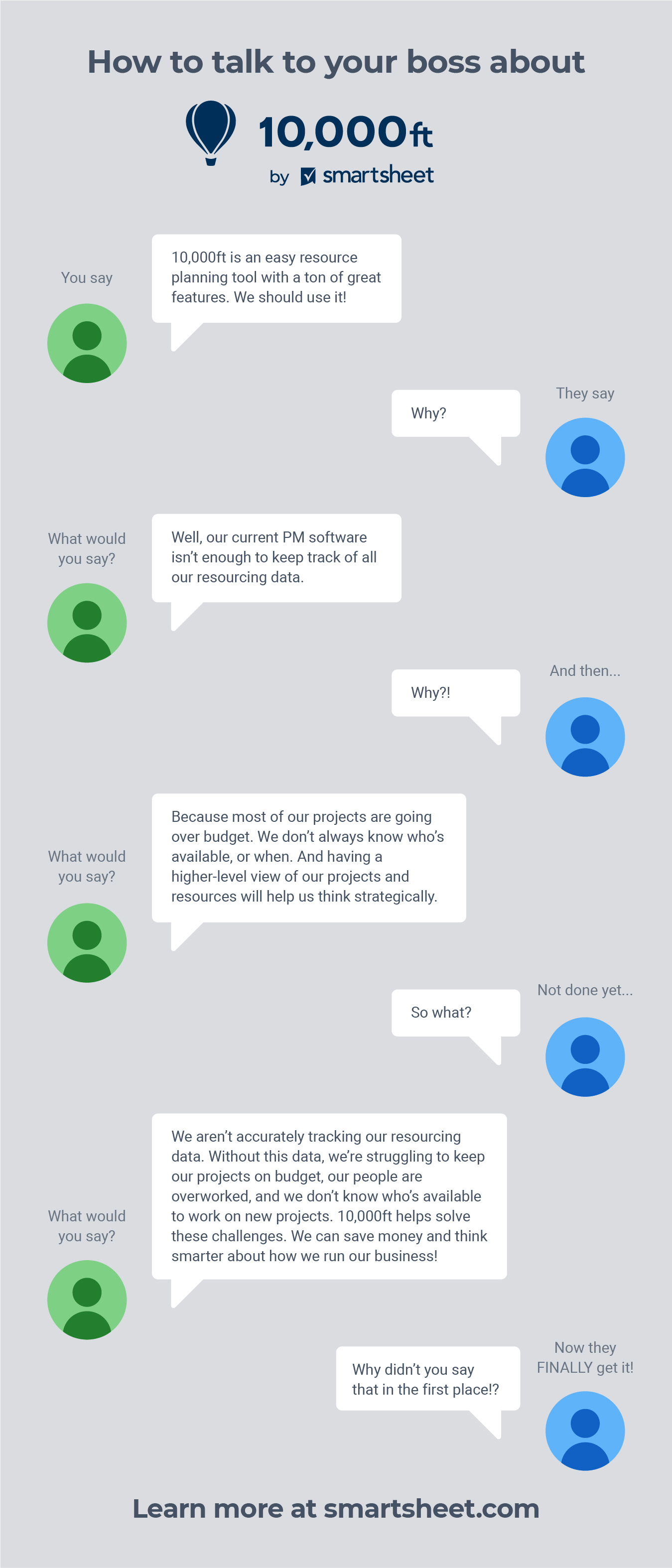I hate to break it to you, but right now you’re the only one hyped about the new piece of software you found.
It does everything you need it to.
It solves a real pain point in your daily routine.
And it’s the least important thing in your boss’ life right now.
You did your due diligence, evaluating all your options to find the perfect solution to improve your company’s processes. But you need to win over your boss (and maybe even your boss’ boss) before anyone will feel those benefits.
So, how can you win them over? Once you set a meeting, how do you build a solid business case to convince your boss to endorse new software?
Highlight the benefits
To make your case for new software, start by illustrating the benefits of using it.
There are two kinds of benefits to cover:
Tangible benefits are things like budget, investment, and ROI. If you see that only one in every four projects comes in at or under budget, for example, you could calculate the cost savings of improving that number to keep more projects within budget. Numbers that show a positive impact to the bottom line are hard for any smart leader to ignore.
Intangible benefits, like employee experience and customer service, are more difficult to show. People may feel these benefits as a result of using the software, even though they’re not directly related.
If your company is struggling with timesheet compliance, for example, software itself may not directly solve your challenge. But you can still help your boss understand how much time, energy, and frustration goes into tracking hours on a daily basis, and how much better this new software is for the same purpose. Improved time tracking = an easier process = less frustration = happier employees.
But wait! Your work isn’t over yet. Your boss may understand the benefits, thanks to your research and math skills, but implementing new software means a major disruption to an established company workflow.
To really convince your stakeholders that the change is worth it, you need to motivate their Elephant.
Motivate the elephant
People are naturally resistant to change. They don’t want to change the way they work, and they don’t want to be forced to learn something new, unless you can convince them that it’s worth their time.
Change is so difficult because the rational and emotional sides of our minds are constantly competing for control. You can only convince others to change when you put this tension in check and help both sides move in the same direction.
University of Virginia psychologist Jonathon Haidt uses a metaphor of a Rider and an Elephant to capture this tension. In their book, Switch, Chip and Dan Heath explain:
“Haidt says that our emotional side is the Elephant and our rational side is the Rider. Perched atop the Elephant, the Rider holds the reins and seems to be the leader. But the Rider’s control is precarious because the Rider is so small relative to the Elephant. Anytime the six-ton Elephant and the Rider disagree about which direction to go, the Rider is going to lose. He’s completely overmatched.”
Though your proposal may be about new software on the surface, on a deeper level you’re asking your boss to change the way people work. Everyone on your team will need to adopt new behaviors to make the most of the software.
The problem is, when people don’t know what to expect, the process of change is ambiguous, and their Elephant gets spooked. It’s reluctant to move. No matter how hard the Rider prods, analytical arguments won’t change their minds.
So, to motivate the Elephant, think about how you can present your evidence in a way that makes your boss feel something.
Get past the spam filter
Chances are, when you approach your boss with this proposal, she’s already thinking about a million other things. She’s planning for the leadership meeting in an hour. The numbers were down last month, and she’s thinking about how to improve them.
When you’re bringing new software to the table, you need to provide a compelling reason for them to care. Otherwise, you’re going to get filtered out among all these other thoughts, they won’t pay attention, and they’ll forget the conversation as soon as you leave the room.
To get past their brain’s “spam filter” (thanks, Kathy Sierra), you need to accomplish three things with your proposal:
- Keep it simple. Don’t give the brain unnecessary or unimportant information to filter through. Cut to the core of what you’re trying to say and leave out the fluff.
- Create a feeling. People respond when you’re able to connect to their deeper emotions. Instead of relying on numbers, paint them a picture. Tell a story around the challenge you’re trying to solve. Help them feel the gravity of your words.
- Make it compelling. Flashy charts and graphics aren’t going to compel your boss to act. They’re likely suspicious, if not cynical, by the time they sit down with you. To capture their attention, you need to give them a big, compelling reason why they need to act.
You can identify the most compelling reasons behind your new software proposal by asking “Why?” until you get to the core of the issue and motivate their Elephant.
Here’s an example with a shameless plug:
At the end of the day, your boss is looking for the return on investing in this shiny new software. They need to understand how it helps the company, what it’s going to change, and whether that change effort is worth the price tag.
It’s your job to show them the benefits, motivate their Elephant, and help them understand (and feel) how this new software helps the company succeed. Done well, you’ll have a champion by your side, and you’ll both walk away feeling good about your decision to move forward.


